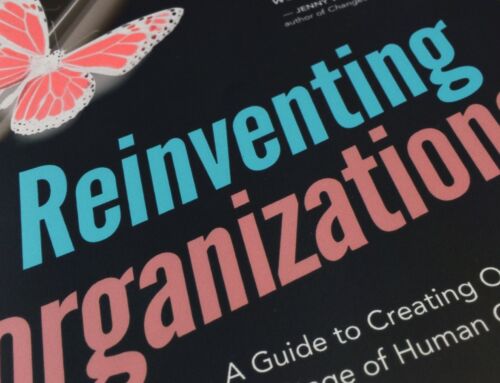At the heart of O2 is self-organization. We know that distributing authority and allowing a group to self-manage is far more effective than treating people like gears, part of a machine. But fostering self-organization is no easy task. We are conditioned to take orders and wait for the action to come from the outside.
A key element for self-organization to happen is transparency. Using transparency, we can reduce information asymmetry and allow a group to have access to everything it needs to constantly adapt and make good decisions. For coordination to take place in a distributed manner, everyone must have the big picture. Not just a bunch of people that were chosen to lead.
In O2, the review mode ensures that people has access to this big picture.
Reviewing the work
Few groups put energy into creating a moment together to look and reflect on their work. Some believe that this is a waste of time. Others have never tried. When we begin a review routine, it is common to hear:
Wow, it’s great to be in this meeting. I was always locked in room X doing Y and didn’t even know what was happening in the company.
Without a review routine, it’s too much to expect that someone who knows nothing of what is happening will be proactive and make decisions.
In O2, there is no exact prescription about how to do the review mode. It’s up to the facilitator to decide what is most appropriate. But in general, the triad checklists, metrics and projects from Holacracy is a good start.
Checklists, Metrics and Projects
A simple way to review the work is by using these 3 elements proposed by Holacracy. Checklists can give visibility if recurring activities are being completed or not. In general they are associated with roles and report whether something happened in a certain period or not. For example, the Website Manager role might have the following checklist: Website backed up? He would then report and answer this question with yes or no during the review mode.
Metrics also show critical information, but they go beyond the binary answer of the checklist. Many organizations and teams are already used to looking at numbers, so no big news here. The change is that in review mode we only briefly report the data, without much discussion.
Projects aim to give transparency about initiatives tied to roles that aren’t recurrent and that also aren’t easily measurable. A project is any outcome you want to achieve and that requires 2 or more steps. The role of Website Manager could have the following project: New branding changes applied to the site. In review mode, participants are invited to bring updates about their projects.
These 3 elements are a good starting point for anyone who is beginning to practice review mode. Either way, the format can be changed to account for the needs of each circle. For example, some groups don’t have many recurring activities, so checklists may not make sense. Other groups work with sales, so a quick review of the sales pipeline might be interesting.
Mastering the review mode
The purpose of the review mode is to give transparency about the work of the circle. In our experience, the shorter and more straightforward the better. Avoid doing time consuming activities or exhaustively reviewing all projects the circle is working on. If the process takes too long, people will get tired. Try to keep it shorter than 20-30 minutes. Remember that the whole circle will probably be participating. Delving into specific issues that don’t interest everyone is probably not a good path.
A tension generator
Throughout the review mode, participants will probably feel many creative tensions. By visualizing the current situation of their work (the big picture), people will quickly identify problems and opportunities from the roles they represent. In O2, we call this tensions.
There is no room to address these issues in the review, as this could undermine the transparency it aims to create. The “processing” of each of the sensed tensions is usually done in the synchronize and adapt modes, which have specific formats to accomplish this. In the next post we’ll talk about them. ;)





[…] combination with a crystal clear organizational structure and a work review routine, the sync mode becomes especially powerful. As we wrote in the previous post, in the review […]